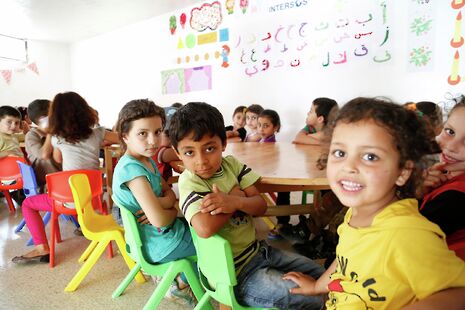Syrian refugees, Nazi Germany and the lessons we can learn from history
The British response to refugee children from Nazi Germany shows how, and how not, to respond to the current migrant crisis

Last month, Prime Minister David Cameron announced that Britain would accept more unaccompanied Syrian child refugees already in Europe. Although he has accepted a revised amendment to Labour Peer Lord Dubs’ Immigration Bill, he will not release a quota until after consultation with local councils. This apparent U-turn was sparked by mounting pressure on the PM, including from Jewish refugees who arrived in Britain on the Kindertransport between 1938 and 1940, a government initiative which took 10,000 Jewish children from Nazi Germany following the violent pogrom known as ‘Kristallnacht’.
Sir Eric Reich, Chairman of the Kindertransport-Association of Jewish Refugees, has been a leading voice in the campaign for the government to make Britain a ‘safe haven’ for ‘children fleeing the persecution in war-torn Syria’. Based on the life-saving experience that allowed him and fellow child refugees to turn ‘adversity into triumph’, Reich has urged the government to demonstrate ‘humanitarian compassion’ and offer the same chance to Syrian children. Such a recommendation found promise in Lord Dubs’ Bill, which proposed that the government take in 3000 unaccompanied child refugees already in Europe. The call to help more of these unaccompanied minors came amid reports that there are currently around 95,000 refugee children in Europe without their parents.
Not only has there been backlash against the proposal – in late April the Commons voted down the bill – but there has also been fierce criticism of the historical comparison made between the Kindertransportees and the Syrian refugee children. But is such criticism necessary? It is useful? The Telegraph’s Allison Pearson has vehemently argued that ‘the plight of the Syrian refugees is not on a par with Jews fleeing the Nazis’. But while her article justifies the case for not taking in children refugees from Syria, her criticisms are seriously problematic.
Despite claiming that the comparison is invalid, Pearson makes the almost unbelievable assertion that ‘not all adults are like those selfless Kindertransport parents who despatched their children with no expectation of seeing them again’. Here she is warning against the risk of unaccompanied children being followed by – God forbid – up to ‘nine relatives’. For a start, the purpose of the proposal to take in 3000 unaccompanied children is that they are just that: unaccompanied. And often orphaned. Secondly, when did we begin shaming displaced families hoping to be reunited?
Flaws in arguments like Pearson’s don’t stop there. Additionally, what good does it do to create a historical hierarchy of human suffering? I don’t wish to compare the plight of the Syrian and Jewish refugees; it goes without saying that the two cases are vastly different. There is also, of course, the point that, as Cameron himself has recognised, we would be taking in refugees from within Europe, particularly Italy, France and Greece. That is to say, not dictatorships or Nazi Germany, engaging in genocide and war, but stable and prosperous liberal democracies.
No historical comparison is ever perfect. As a History student with a particular interest in the Holocaust and its aftermath, I understand the enormity of its damage and the abhorrence of the crimes committed, while recognising that it is not right to liken the destruction of European Jewry to subsequent historical events. This is true for almost all events and trends in history: each situates itself within a distinct period, environment and demographic with unique political, social and economic conditions. Instead of trying to see the two examples of gross human suffering and loss as either equal or different, we should simply seek to understand the Kindertransport as a precedent for British immigration policy towards those abroad and in desperate need.
If we are really going to draw a comparison, it should be in recognising the insufficiency of Britain’s immigration policy towards European Jews in the 1930s and during WWII: it saved far too few. Only 70,000 Jews out of almost 600,000 applicants were rescued, a figure excluding the many more off-record hopefuls. Indeed, the Kindertransport itself was only facilitated when private individuals and organisations, mostly Anglo-Jewish, agreed to foot the bill. Upon arrival, 1,000 of the children were interned as enemy aliens in a camp on the Isle of Man.
Policy makers should learn from history. This time, Britain should not fall guilty of abandon. We should aim to emulate cases where it has saved lives and compensate for past inadequacies. Of course, this crisis is not to be shouldered by the UK alone, and European and extra-European nations should work internationally to find fair, compassionate and workable solutions.
Yes, the Kindertransport-Syrian refugee comparison is flawed, but this should not be used to justify inaction – the Kinder initiative serves as a useful precedent of both how, and how not, to solve the Syrian refugee crisis. Perhaps it is so often harked back to simply because it serves as one of the only truly successful and benevolent immigration policies in modern British history.
 Comment / Plastic pubs: the problem with Cambridge alehouses 5 January 2026
Comment / Plastic pubs: the problem with Cambridge alehouses 5 January 2026 News / Cambridge businesses concerned infrastructure delays will hurt growth5 January 2026
News / Cambridge businesses concerned infrastructure delays will hurt growth5 January 2026 News / New movement ‘Cambridge is Chopped’ launched to fight against hate crime7 January 2026
News / New movement ‘Cambridge is Chopped’ launched to fight against hate crime7 January 2026 News / AstraZeneca sues for £32 million over faulty construction at Cambridge Campus31 December 2025
News / AstraZeneca sues for £32 million over faulty construction at Cambridge Campus31 December 2025 Interviews / You don’t need to peak at Cambridge, says Robin Harding31 December 2025
Interviews / You don’t need to peak at Cambridge, says Robin Harding31 December 2025









